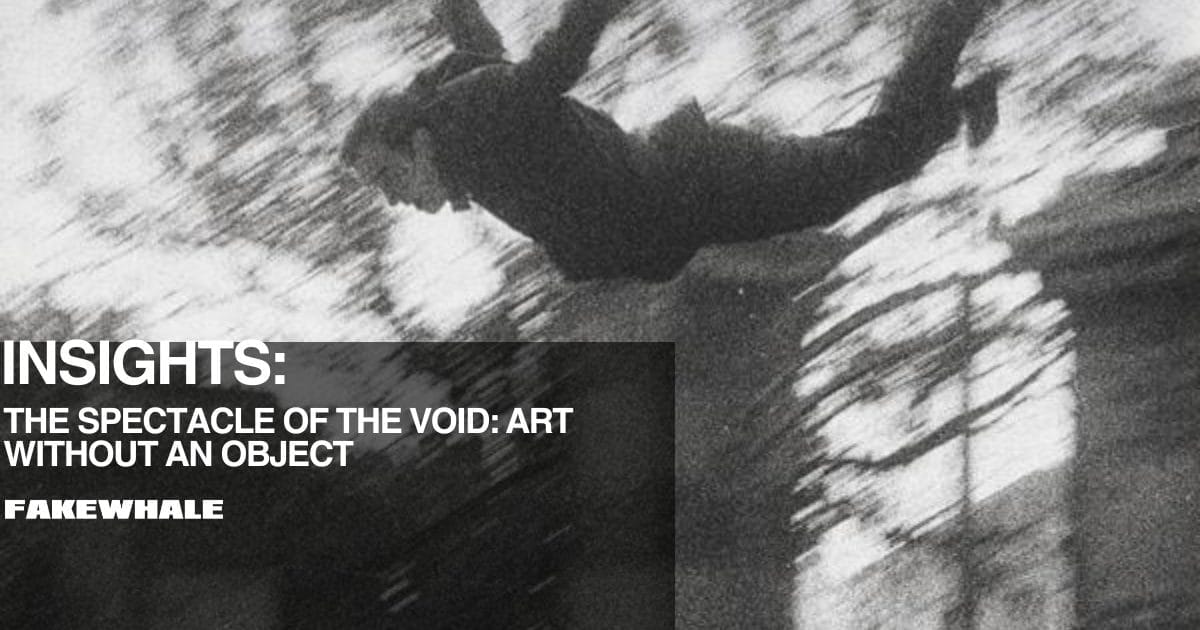In this issue, we’re pleased to present a compelling exploration by the Fakewhale editorial team into the radical aesthetics of invisibility, an investigation of the “artwork without an object” as both conceptual provocation and political refusal in today’s hyper-visible world.
In the most extreme forms of conceptual art, the artistic gesture tends to vanish, dissolving into the thought that generates it. The “invisible artwork” emerges as both paradox and provocation, a declaration of war. It offers no object, no image, no body to contemplate, only an idea that endures through its own disappearance. This is an art of absence, of traces, of promises left unfulfilled. An art that exists through its own withdrawal.
In 1958, Yves Klein opened a now-legendary exhibition at the Galerie Iris Clert titled The Specialization of Sensibility in the Raw Material State into Stabilized Pictorial Sensibility, better known as The Void. The gallery was completely empty. But Klein didn’t stop at the physical absence of the work, he staged a full-blown vernissage with a red carpet, Republican Guards, and champagne. The event became a theatrical mise-en-scène, a symbolic act that magnified the evocative power of nothingness. The artwork was the void itself, orchestrated as a celebration of pure sensibility. To promote his next exhibition, Klein commissioned a photograph of himself seemingly leaping into the void from a Parisian window: Le Saut dans le vide (1960). In reality, the jump was a photographic illusion, a montage. Once again, the action never truly happened, but it existed as a mental image, as provocation.
This tension between presence and absence reappears in more recent works, such as those of Florence Jung, an artist who has built an entire practice around intentional invisibility. Her pieces, often titled with numbers like jung58 or jung89, are rarely documented. They cannot be seen, purchased, or preserved. These are ephemeral actions, unannounced, sometimes even unsuspected. In one piece, she hired a person to cry convincingly in a shopping mall for a set period of time. The work wasn’t recorded or traceable, it lives only in the uncertainty of those who may have witnessed it. In jung45, Jung subtly altered a gallery’s playlist by inserting a track that subtly unsettled the environment, without notifying anyone. Once again, the art hides in the margins, in the interference.

Yves Klein (1928–1962), in collaboration with Harry Shunk (1924–2006) and Jànos Kender (1937–2009), Le Saut dans le vide.
This act of concealment echoes earlier works like Joseph Kosuth’s One and Three Chairs (1965), where the physical object is interrogated by the idea, the language, and its representation. Or John Baldessari’s I Will Not Make Any More Boring Art (1971), in which the work is a performative promise, a mantra repeated as a denial of the act of making.
But the apex of this tension is reached in works that deny their own material existence. In Untitled (A Curse) (1992), Tom Friedman commissioned a Haitian witch doctor to place a curse on a plain white pedestal. The result is a piece that can’t be seen or heard, but “acts” as an invisible threat. Similarly, the entire body of work by Tino Sehgal consists of choreographed situations and conversations activated by the audience, none of which can be photographed, filmed, or documented. They exist solely in the memory of those who experience them.
The “invisible artwork” thus radicalizes a core artistic urgency: to shift art from matter to consciousness, from form to possibility, from object to thought. It is an art that doesn’t aim to exist for everyone, only for those willing to find it where it refuses to be seen.

David Horvitz, from wherever you are, walk towards the ocean, 2022
Starting in the 1970s, invisibility became not just an aesthetic choice but also a political stance. Adrian Piper, for instance, in her Catalysis series (1970–1971), performed a set of disturbing and subtly theatrical public interventions, riding a bus with a dirty towel stuffed in her mouth, or walking through the city in clothes soaked with foul-smelling liquids. No one recognized her as an artist. There was no stage, no label. The artwork existed solely in the interference between her and the world, in the short circuit between social expectations and the real body. And it’s precisely this liminal condition, being seen without being recognized, that made her invisible as an artist, yet hyper-visible as disruption.
Around the same time, Chris Burden created 5 Day Locker Piece (1971), in which he locked himself inside a metal locker at a university for five days. No one could see him. There was no visible action, no movement. The audience stood before a closed, silent surface, and the work lay in the awareness of the gesture itself, in the evocative power of the information: “the artist is in there.” A physical presence turned into a visual absence.(…)
READ NOW ↓
USEFUL LINKS:



